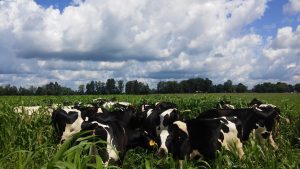Brook Wilke, Farm Manager at MSU’s W.K. Kellogg Biological Station writes about integrating annuals into a grazing system and making the most out of the investment. This blog was originally featured in the online edition of The Farmer’s Exchange.
~~~~~~~~~~~~~~~~~~~~~~~~~
Diverse mixtures of perennial plants are the backbone of our grazing systems in the Midwest. Pastures planted (or occurring naturally) with these mixtures offer many benefits, including deep  roots to maximize nutrient and water uptake, no need for replanting, tolerance, or even benefit from, grazing the biomass, weed suppression, etc. I could go on and on regarding the benefits of these perennial plants, but there are times when annual crops might provide some unique benefits for graziers.
roots to maximize nutrient and water uptake, no need for replanting, tolerance, or even benefit from, grazing the biomass, weed suppression, etc. I could go on and on regarding the benefits of these perennial plants, but there are times when annual crops might provide some unique benefits for graziers.
Planting annual crops for grazing adds cost to the system. Existing vegetation needs to be terminated, seeds need to be purchased and planted, and there’s a time period where grazing cannot occur while the new plants are getting established. But, these costs can be recovered because annual forages offer three key benefits over perennials. These include: 1) Potential for increased total biomass production, 2) Forage production during the periods of poor perennial plant growth (summer, late fall), and 3) Potential for higher quality forage for high-performance animals such as dairy or finish period of lambs or steers.
For these reasons above, it’s worthwhile to consider integrating some annuals into the grazing system to improve your overall profitability. But, it’s important to take notice of the following tips to help you manage these crops to make the most out of your investment.
- Plant annual forages in pastures or fields where you want to establish new perennial pastures in the long run. Crop rotations with perennials and annuals over time work very well. We’ve found that seven years of perennials followed by three years of annuals, and then back to perennials is a good rotation. Cultivating annual crops for three years helps to eliminate problem weeds in perennial pastures, making establishing perennial species easier.
- Wait until June to terminate perennial pastures and plant annuals. Nearly half of the growth from perennial pastures occurs during the spring months of April May and early June, so we want to take advantage of that growth, and then establish the annual crops after the peak growth period for the perennials has passed. Herbicides and tillage both work to terminate perennial pastures; sometimes two passes are needed to get good control.
- Double cropping annual forages is key to profitability. For example, plant a full season crop of sudex in June, grazing up to three times across the summer, and then follow that with a winter cereal such as triticale in the fall, which will be grazed once or twice in the spring. Similarly, spring-planted cereals such as oats can be grazed in June, and then followed with brassica crops (kale, rapeseed, radishes, etc.) for late fall/winter grazing. Mixtures can be used also, but make sure the species grow well together, rather than one species out-competing the others. The key is to have crops growing all year round in order to grow more total forage compared to the perennial mixtures elsewhere on the farm, which is essential to recover the extra cost of planting annuals.
- Often times, relay cropping (planting the next crop into the previous standing crop) can be used to avoid the need to till or use herbicides to kill the previous crop. A great example is planting a winter cereal (e.g. triticale) immediately after grazing sudex in September. The sudex will die with the first frost in October but will compete with weeds until then while the triticale is getting established.
- Graze annual crops by utilizing strip or mob grazing techniques. This is important to limit trampling and increase utilization of the crops, and also to encourage regrowth of those crops that will regrow after grazing.
There’s so much fun to be had with growing annual crops for grazing. Explore these options and how they might fit on your farm, but be sure to manage them well to take full advantage of the investment.

10461 N. 40th St.
Hickory Corners, MI 49060
(269) 671-2402
kelloggfarm@kbs.msu.edu